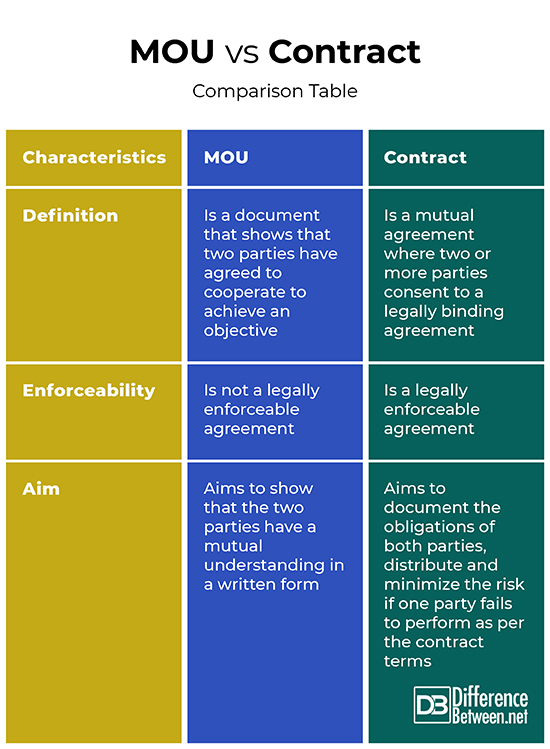Difference Between MOU and Contract
You may have come across various types of agreements or even signed a few either at work, while renting an apartment or even in business. The importance of signing legally binding agreements cannot be ignored. Agreements not only ensure that the terms and conditions outlined in an are enforced but can also be imposed legally. The terms Memorandum of Understanding (MOU) and contracts are often used interchangeably. However, the two have differences.

What is Memorandum of Understanding (MOU)?
This is a document that shows that two parties have agreed to cooperate to achieve an objective. The purpose of MOU’s is to show that the two parties have a mutual understanding in a written form.
They are great to start a recognized and formal partnership with other parties. They also contain little obligation and are often general or specific as needed.
Mostly, the parties involved in a MOU do not intend to have a legally enforceable agreement. As such, these documents tend to not contain legally binding terms.
If one party fails to fulfil an obligation as stipulated in the MOU, the other party can not have the agreement legally enforced.

What is a Contract?
This is a mutual agreement where two or more parties consent to a legally binding agreement. A contract can only be legally binding where two parties have entered into a legally binding agreement.
The purpose of a contract is to document the obligations of both parties, distribute and minimize the risk if one party fails to perform as per the contract terms.
For a contract to be legally binding, it must have;
- An offer
- Acceptance
- It must be made with the will to create a legal relationship
- It must have consideration from both parties
If one party fails to fulfil the contract terms, the other party can have it legally enforced.
Similarities between MOU and Contract
- Both have an offer that must be accepted
- They must have two or more parties
- Parties involved have to agree on the same thing
Differences between MOU and Contract
Definition
MOU is a document that shows that two parties have agreed to cooperate to achieve an objective. On the other hand, a contract is a mutual agreement where two or more parties consent to a legally binding agreement.
Enforceability
While an MOU is not a legally enforceable agreement, a contract is a legally enforceable agreement.
Aim
An MOU aims at showing that the two parties have a mutual understanding in a written form. On the other hand, a contract aims at documenting the obligations of both parties, distribute and minimize the risk if one party fails to perform as per the contract terms.
MOU vs. Contract: Comparison Table

Summary of MOU vs. Contract
MOU is a document that shows that two parties have agreed to cooperate to achieve an objective. It is not legally enforceable and aims to show that the two parties have a mutual understanding in a written form. On the other hand, a contract is a mutual agreement where two or more parties consent to a legally binding agreement. It is legally binding and aims to document the obligations of both parties, distribute and minimize the risk if one party fails to perform as per the contract terms.
- Difference Between Profit Center and Investment Center - July 2, 2022
- Difference Between Anti-Trust and Anti-Competition - June 6, 2022
- Difference Between Stocktaking and Stock Control - June 6, 2022
Search DifferenceBetween.net :
Leave a Response
References :
[0]Arjan Van Weele. International Contracting: Contract Management in Complex Construction Projects. World Scientific, 2014.https://books.google.co.ke/books?id=7za6CgAAQBAJ&pg=PA243&dq=Difference+Between+MOU+and+Contract&hl=en&sa=X&ved=2ahUKEwiu2bSrlKvuAhUJhRoKHeFODY0Q6AEwAHoECAQQAg#v=onepage&q=Difference%20Between%20MOU%20and%20Contract&f=false
[1]Richard Stone. The Modern Law of Contract. Psychology Press, 2005.https://books.google.co.ke/books?id=uLd4qy7LJJYC&pg=PA180&dq=contracts&hl=en&sa=X&ved=2ahUKEwjEqNOUlavuAhUPzIUKHbNSCasQ6AEwBHoECAQQAg#v=onepage&q=contracts&f=false
[2]Steven Emanuel. Contracts. Aspen Publishers Online, 2006.https://books.google.co.ke/books?id=0AukV989i50C&pg=RA1-PA72&dq=contracts&hl=en&sa=X&ved=2ahUKEwjEqNOUlavuAhUPzIUKHbNSCasQ6AEwBnoECAcQAg#v=onepage&q=contracts&f=false
[3]Image credit: https://commons.wikimedia.org/wiki/File:Sister_City_Memorandum_of_Understanding.jpg
[4]Image credit: https://pixabay.com/illustrations/contract-signing-hand-signature-4085336/
